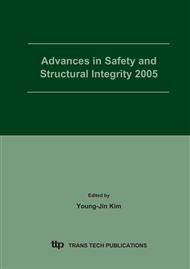p.63
p.71
p.79
p.89
p.97
p.105
p.111
p.117
p.123
Application of Ultrasonic Phased Array Techniques for Inspection of Stud Bolts in Nuclear Power Plants
Abstract:
The reactor vessel body and closure head are fastened with the stud bolt that is one of crucial parts for safety of the reactor vessels in nuclear power plants. It is reported that the stud bolt is often experienced by fatigue cracks initiated at threads. Stud bolts are inspected by the ultrasonic technique during the overhaul periodically for the prevention of failure which leads to radioactive leakage from the nuclear reactor. The conventional ultrasonic inspection for stud bolts was mainly conducted by reflected echo method based on shadow effect. However, in this technique, there were numerous spurious signals reflected from every oblique surfaces of the thread. In this study, ultrasonic phased array technique was applied to investigate detectability of flaws in stud bolts and characteristics of ultrasonic images corresponding to different scanning methods, that is, sector and linear scan. For this purpose, simplified stud bolt specimens with artificial defects of various depths were prepared.
Info:
Periodical:
Pages:
97-104
Citation:
Online since:
March 2006
Authors:
Price:
Сopyright:
© 2006 Trans Tech Publications Ltd. All Rights Reserved
Share:
Citation:


